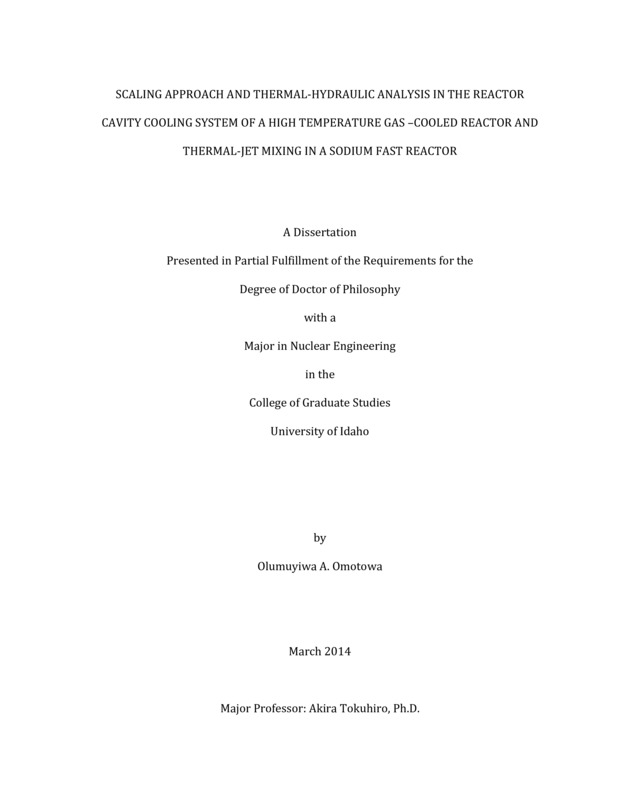SCALING APPROACH AND THERMAL-HYDRAULIC ANALYSIS IN THE REACTOR CAVITY COOLING SYSTEM OF A HIGH TEMPERATURE GAS -COOLED REACTOR AND THERMAL-JET MIXING IN A SODIUM FAST REACTOR
Omotowa, Olumuyiwa. (2014). SCALING APPROACH AND THERMAL-HYDRAULIC ANALYSIS IN THE REACTOR CAVITY COOLING SYSTEM OF A HIGH TEMPERATURE GAS -COOLED REACTOR AND THERMAL-JET MIXING IN A SODIUM FAST REACTOR. Theses and Dissertations Collection, University of Idaho Library Digital Collections. https://www.lib.uidaho.edu/digital/etd/items/omotowa_idaho_0089e_10158.html
- Title:
- SCALING APPROACH AND THERMAL-HYDRAULIC ANALYSIS IN THE REACTOR CAVITY COOLING SYSTEM OF A HIGH TEMPERATURE GAS -COOLED REACTOR AND THERMAL-JET MIXING IN A SODIUM FAST REACTOR
- Author:
- Omotowa, Olumuyiwa
- Date:
- 2014
- Keywords:
- RCCS Sodium Fast Reactor Thermal-hydraulics Thermal jet mixing
- Program:
- Mechanical Engineering
- Subject Category:
- Nuclear engineering
- Abstract:
-
This dissertation develops and demonstrates the application of the top-down and bottom-up scaling methodologies to thermal-hydraulic flows in the reactor cavity cooling system (RCCS) of the high temperature gas reactor (HTGR) and upper plenum of the sodium fast reactor (SFR), respectively. The need to integrate scaled separate effects and integral tests was identified. Experimental studies and computational tools (CFD) have been integrated to guide the engineering design, analysis and assessment of this scaling methods under single and two-phase flow conditions. To test this methods, two applicable case studies are considered, and original contributions are noted.
Case 1: "Experimental Study of RCCS for the HTGR". Contributions include validation of scaling analysis using the top-down approach as guide to a ¼-scale integral test facility. System code, RELAP5, was developed based on the derived scaling parameters. Tests performed included system sensitivity to decay heat load and heat sink inventory variations. System behavior under steady-state and transient scenarios were predicted. Results show that the system has the capacity to protect the cavity walls from over-heating during normal operations and provide a means for decay heat removal under accident scenarios. A full width half maximum statistical method was devised to characterize the thermal-hydraulics of the non-linear two-phase oscillatory behavior. This facilitated understanding of the thermal hydraulic coupling of the loop segments of the RCCS, the heat transfer, and the two-phase flashing flow phenomena; thus the impact of scaling overall.
Case 2: "Computational Studies of Thermal Jet Mixing in SFR". In the pool-type SFR, susceptible regions to thermal striping are the upper instrumentation structure and the intermediate heat exchanger (IHX). We investigated the thermal mixing above the core to UIS and the potential impact due to poor mixing. The thermal mixing of dual-jet flows at different temperatures and velocities were investigated using COMSOL CFD. CFD simulations show that the flow field is characterized into three regions, and the phenomenon is momentum dominated, thus poor mixing. Thus, the lack of thermal mixing showed CFD can be used as a tool for scaling. Scaling of the SFR pool, IHX and pumps will be important at integral and full-scale.
- Description:
- doctoral, Ph.D., Mechanical Engineering -- University of Idaho - College of Graduate Studies, 2014
- Major Professor:
- Tokuhiro, Akira
- Committee:
- Harris, Jason; Zimmerman, William; Utgikar, Vivek
- Defense Date:
- 2014
- Identifier:
- Omotowa_idaho_0089E_10158
- Type:
- Text
- Format Original:
- Format:
- application/pdf
- Rights:
- In Copyright - Educational Use Permitted. For more information, please contact University of Idaho Library Special Collections and Archives Department at libspec@uidaho.edu.
- Standardized Rights:
- http://rightsstatements.org/vocab/InC-EDU/1.0/

